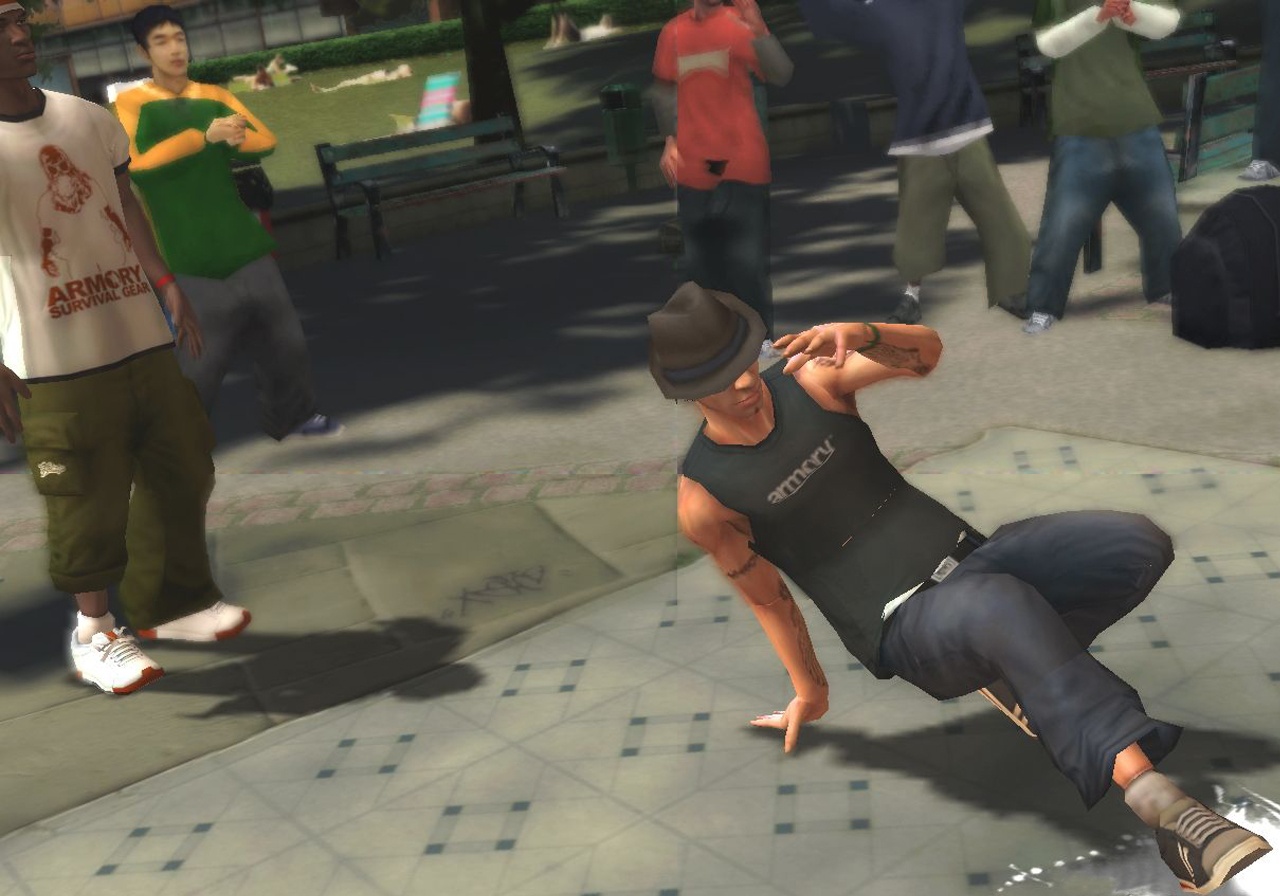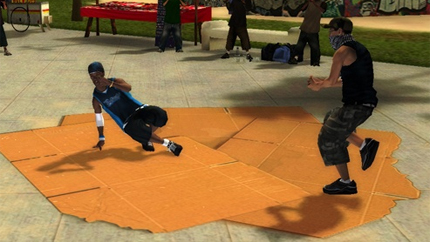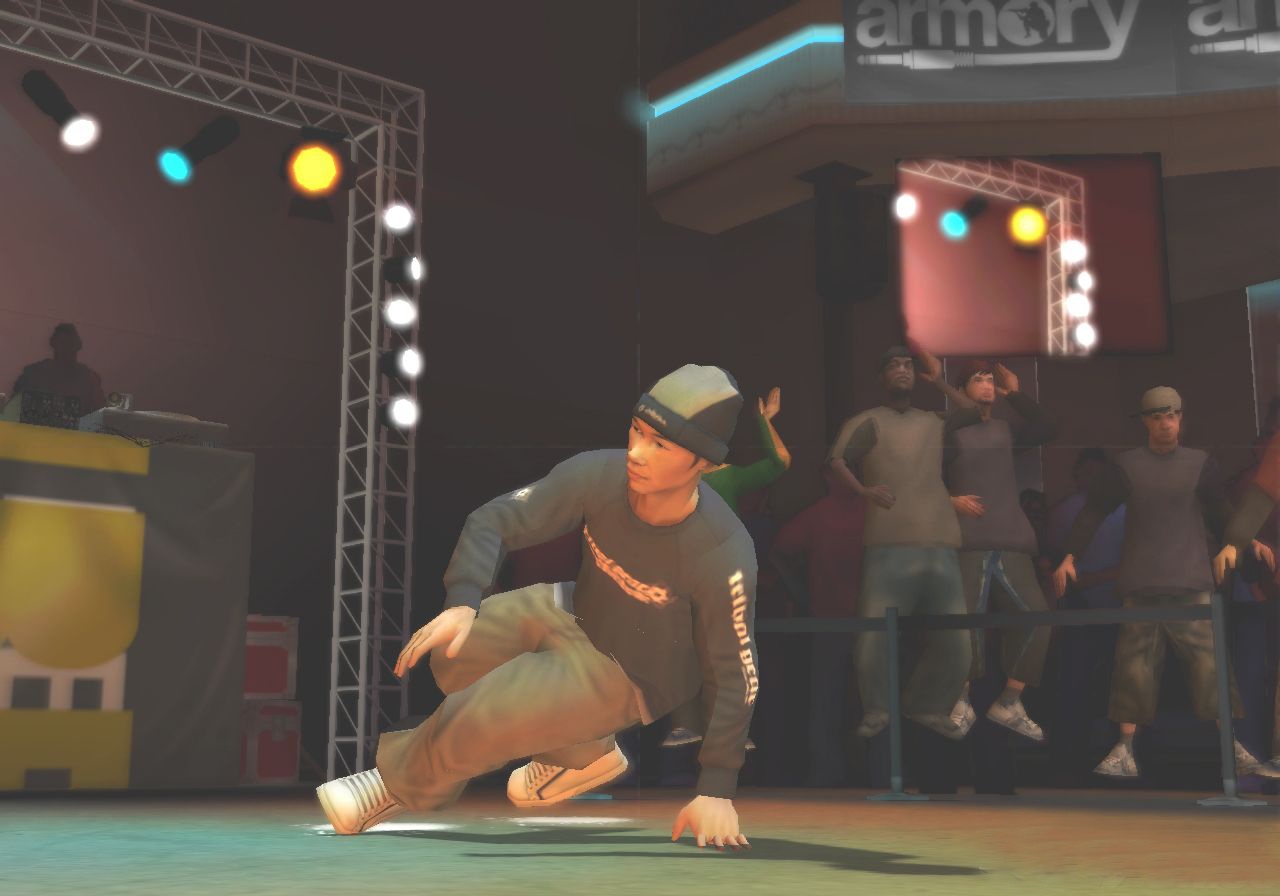B-Boy seems authentic. This break dancing-themed rhythm game talks the talk, walks the walk, and even knows how to top-rock. But underneath its licensed tracks, motion-captured moves, and fancy lingo, B-Boy suffers from several problems, including bad pacing, repetitive play, and no narrative.
The main mode is Livin' Da Life. There's no context: You're just an anonymous avatar who lives in a really nice studio and dances his or her way to the top of a ladder of respected breakers (those who break dance). You don't have any quirks, aside from the hairdo and the face that you give yourself during character creation. Likewise, you aren't from anywhere. Heck, you aren't even living a life; you're just doing the robot.

More specifically, you're top-rocking, six-stepping, windmilling, and freezing. B-Boy's moves are authentic, and its approach to break dancing is appropriate. The majority of the prompts in this game are beat markers that swirl at your feet; you decide what moves to do and when, just like a real break dancer would.
Your moves are split into several groups, but the most important are "basics" and the aptly titled "moves." Your four basics are mapped to the face buttons. For instance, if you press triangle, you'll start top-rocking (a basic move). From there, you can execute "moves" by pressing a directional button once, twice, or thrice, and then the appropriate face button. Thanks to this simple system, you will have a theoretical understanding of every move in the game well before you unlock them all.
However, this transparent scheme gets awfully confusing due to the fact that you gain new moves individually. So even though you know that "up, up, X" is definitely a move, you might not have gotten it yet. This is bad, because attempting moves that you haven't acquired will throw off your rhythm and potentially break up your flow, both of which are big deals in the break dancing world. As a result of this uncertainty, you'll always stick to the streams and the rivers you're used to, which makes B-Boy feel less improvisational than it should.
On top of that, there's the distinction between "moves" and "transitions" to keep straight. A transition modifies a "base" move, and requires only directional button presses to execute. They are automatically unlocked in huge chunks as you play, and they go in your moves list. This should not be confused with your moves book, which is accessible only from the Lab (your apartment, and Livin' Da Life's hub), and it lists only honest-to-goodness "moves." The moves list, on the other hand, is an opaque flowchart that is available during practice. It is a spiderweb of stuff that will confuse you, but the worst part is that every move, transition, and base is listed by name, not button input. So to figure out what you can and can't do, you have to go down the list of names, one by one, and check their individual commands. It's not fun, and by the time you reach the end, you will have forgotten which moves you saw at the beginning.

This all takes place, by the way, in your studio. This is where you practice, use your computer, try on different clothes, and check your moves book. Your computer serves many purposes. You get frequent emails offering small gameplay tips, as well as reminders that you've unlocked new moves. This is also where you can accept challenges. Challenges are short break dancing contests that usually pit you against one or a few other breakers. You have a limited amount of time to pull off more cool moves than your opponent, and if you win, you gain respect. Gain enough of it, and you will become the most respected B-Boy on the block.
Your routine is judged according to five possible criteria: flow, rhythm, flair, creativity, and basics. In early challenges, you may be judged on only flow and rhythm; in later ones, you could be judged on all five. To beat your opponent, you don't have to surpass him or her in every criteria, just the majority of them. So, if all five are being judged, you need a routine that will get you a high score in only three of them. This makes it easy to put together a single routine that you can ride to victory after repetitive victory. Sure, you can throw in finishing moves, entrance moves, and taunts, but these are just wrinkles in an otherwise boring pattern.
Outside of Livin' Da Life, you can play B-Boy Jam mode, which lets you set up quick matches of several different types. The nice part is that you get to use premade breakers, so you don't have to worry about whether or not "up, up, X" has been unlocked. But regardless of whether you're dancing in a showcase match (timed routines) or an open circle (no time limit, several contestants), you're still trying to outdance your opponents while being judged on certain criteria. By the time you've lived enough of da life, you will also have had enough of B-Boy Jam mode.

Whichever mode you're playing, the graphics in B-Boy are not good. The female avatar faces all look old and leathery, and the urban locales in which you dance aren't very interesting. The motion-captured moves are the bright spot, but even these don't look quite right. The physics feel wrong, as if your dancer were somehow doing the moves suspended in the air and not on the pavement. The licensed music is good, and aside from a few sound effects, it provides the only audible element of the game.
You have to give B-Boy credit for taking a novel approach to a relatively untapped subject. But then you have to take all that credit away for the fact that it has no story, a Byzantine move system, and repetitive gameplay. In the end, B-Boy is difficult to pick up, easy to master, and impossible to recommend.